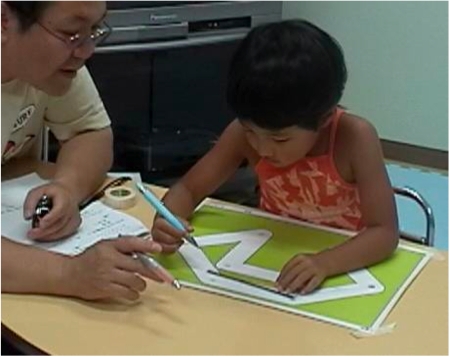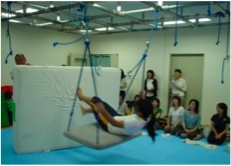
Ph.D. Professor Hiroyuki Inadomi
Recent advancement of medical technologies has enabled human beings to save lives of many children. This fact also indicates that some children have to grow up and develop with physical disabilities, mental disabilities, or higher brain dysfunctions, caused by brain disorders. The prevalence of developmental disabilities (DD) has been increasing, and the government has started support projects.
We conduct research on assessment and intervention for individuals who need support through developmental process. We are also committed to educating therapists working in this field.
Research and Education
Our laboratory focuses on two research projects. The first project aims to develop occupational therapy assessment and intervention methods for DD, mainly autism. Currently, the number of children with DD, who take occupational therapy, is increasing rapidly. However, researches regarding effectiveness of occupational therapy through sensory integration approaches are limited and inconclusive. We are focusing on 1) development of objective assessment tools, 2) therapeutic effectiveness of interaction between therapists and children, 3) effectiveness of school-based occupational therapy.
The second project is on occupational therapy for individuals with cancer. The five-year survival rate of Leukemia, which is the highest in incidence rate among various pediatric cancers, is reported to be 90% at present. However, many of the surviving children have difficulties adapting in schools and at home. Thus, we attempt to investigate assessment and intervention for them.
There are many research fields: hospitals, child development support centers, preschools, regular schools, and special schools.

 Photo1. Development of sensory integration test (bilateral motor coordination)
Photo1. Development of sensory integration test (bilateral motor coordination)
Photo2. Scene of occupational therapy for children with developmental disorders
Publications
- Kanae Matsushima, Toshihiro Kato, Noriko Arai, Ami Tabata (2012) The relation between sensory modulation dysfunctions and intellectual disabilities –A Comparative study using the Japanese sensory inventory-revised-. Japanese Journal of Occupational Therapy in Pediatrics 1, 2-7.
- Noriko Arai, Toshihiro Kato, Souichi Adachi, Kanae Matsushima (2012) Cognitive function and QOL in children after hematopoietic stem cell transplantation. Japanese Occupational Therapy Research 31, 278-289.
- Kanae Matsushima, Toshihiro Kato, Noriko Arai, (2012) Comparative study of Social Responsiveness Scale as a clinical assessment tool in Japan and American children experiencing typical development. Japanese Journal of Pediatrics 65, 303-309.
- Toshihiro Kato, Takashi Yamada (2010) Recent drawings of human figures by typical children: An examination of the difference between recent and original data of the Japanese version of Millere Assessment for Preschooleres (JMAP) and Goodenough Draw a Man Test(DAM). Japanese Occupational Therapy Research 29:743-753.
- Toshihiro Kato, Takashi Yamada (2010) Children’s self-recognition of motor ability . Japanese Occupational Therapy Research 29:73-82.
Laboratory
Professor: Hiroyuki Inadomi
Associate Professor: Toshihiro Kato
Associate Professor: Hitoshi Tanimukai
Assistant Professor: Sayaka Okahashi
TEL: 075-751-3943
FAX: 075-751-3943
e-mail: inadomi.hiroyuki.5e atmark kyoto-u.ac.jp
